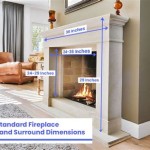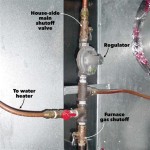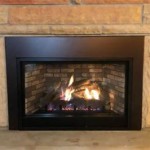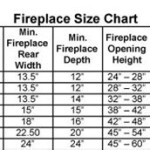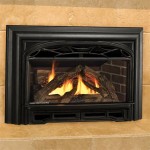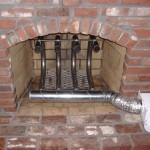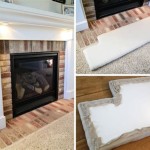Choosing the Right Trim for Your Fireplace Surround
The fireplace is often the focal point of a room, providing warmth, ambiance, and a gathering place for friends and family. A well-designed fireplace surround enhances this focal point, and the trim plays a crucial role in achieving the desired aesthetic. Selecting the appropriate trim for a fireplace surround involves considering several factors, including the style of the room, the material of the surround, and the desired level of detail. Understanding these elements will ensure a cohesive and visually appealing result.
Trim serves multiple purposes in a fireplace surround. It defines the edges, adds visual interest, and can even conceal imperfections in the construction. The right trim can elevate a simple surround to a sophisticated design element, while the wrong choice can detract from the overall appearance. Therefore, careful consideration is essential when selecting trim for a fireplace.
Material Considerations for Fireplace Surround Trim
The material of the trim is a primary consideration. Several options are available, each with its own advantages and disadvantages. The most common materials for fireplace surround trim include wood, MDF (Medium-Density Fiberboard), stone, and metal.
Wood trim is a classic choice, offering warmth and versatility. It can be painted or stained to match the surrounding decor and is available in a variety of profiles, from simple and understated to ornate and elaborate. Hardwoods like oak, maple, and cherry are popular choices due to their durability and attractive grain patterns. However, wood trim requires proper sealing and finishing to protect it from moisture and heat, which can cause warping or cracking over time. Regular maintenance is necessary to preserve its appearance and integrity.
MDF trim is a cost-effective alternative to solid wood. It is made from compressed wood fibers and resin, resulting in a smooth, consistent surface that is ideal for painting. MDF is less prone to warping than solid wood and is generally easier to work with. However, it is not as durable as hardwoods and is more susceptible to damage from moisture. MDF trim is best suited for applications where it will be painted and protected from excessive humidity.
Stone trim offers a natural and rustic aesthetic. It can be made from various types of stone, including marble, granite, and limestone. Stone trim is highly durable and fire-resistant, making it an excellent choice for fireplace surrounds. However, it is also more expensive than wood or MDF and requires specialized installation techniques. The weight of stone trim can also be a factor, as it may require additional structural support. Stone trim is best suited for fireplaces that are designed to have a natural or contemporary look.
Metal trim provides a sleek and modern appearance. It can be made from various metals, including stainless steel, brass, and copper. Metal trim is durable, fire-resistant, and relatively low-maintenance. It adds a touch of sophistication and can be easily incorporated into contemporary designs. However, metal trim can be expensive and may require specialized tools for installation. It is best suited for fireplaces that are designed to have a modern or industrial aesthetic.
Style and Profile of Fireplace Surround Trim
The style and profile of the trim should complement the overall design of the room and the fireplace surround. The profile refers to the shape and dimensions of the trim. Different profiles can create different visual effects, ranging from subtle and understated to bold and dramatic. Consider the architectural style of the home when selecting a trim profile.
For traditional homes, ornate trim profiles with intricate carvings and moldings are often appropriate. These profiles add a touch of elegance and sophistication to the fireplace surround. Common traditional trim profiles include crown molding, base molding, and chair rail molding. These profiles often feature curves, details, and layered elements.
For contemporary homes, simpler and more minimalist trim profiles are typically preferred. These profiles emphasize clean lines and geometric shapes. Common contemporary trim profiles include flat stock, square edge profiles, and bullnose profiles. These profiles create a sleek and uncluttered look that complements modern design aesthetics.
The color and finish of the trim should also be considered. Painted trim is a popular choice, as it allows for a wide range of color options and can be easily updated to match changing decor. Stained trim showcases the natural beauty of the wood grain and adds warmth to the room. The finish of the trim can also affect its appearance. A glossy finish will reflect light and create a more formal look, while a matte finish will absorb light and create a more casual look.
Installation Considerations for Fireplace Surround Trim
Proper installation is crucial to the longevity and appearance of the fireplace surround trim. The installation process will vary depending on the material of the trim and the construction of the surround. Whether a professional is hired, or the task is DIY, certain considerations are paramount.
Wood and MDF trim can be installed using nails, screws, or adhesive. It is important to ensure that the trim is properly aligned and secured to the surround. Gaps and imperfections should be filled with wood filler and sanded smooth before painting or staining. Corner joints should be mitered or coped for a clean and professional look. Safety glasses and dust masks should be worn during the installation process.
Stone and metal trim require specialized installation techniques. Stone trim typically requires mortar or thin-set adhesive to be installed. The weight of the stone may require additional structural support. Metal trim can be installed using screws, rivets, or adhesive. It is important to use corrosion-resistant fasteners to prevent rust and discoloration. Professional installation is recommended for stone and metal trim to ensure a secure and aesthetically pleasing result.
Before installing any trim, it is essential to ensure that the fireplace surround is clean, level, and properly prepared. Any existing trim should be removed and the surface should be sanded smooth. Prime the surface before painting or staining to ensure proper adhesion. Always consult local building codes and regulations before undertaking any fireplace surround renovation project. It is advisable to consult with a qualified contractor or designer to ensure that the trim is correctly specified and installed.

Fireplace Mantel Design And Creation By Jl Molding In New Jersey

Diy Faux Plaster Fireplace Surround Chelsey Freng

Diy Farmhouse Trim Above The Fireplace Top Shelf

Makeover Fireplace This Winter To Look Good For Summer Intrim Mouldings

Fireplace Molding Ideas Adding Visual Interest And Height

Fireplace Trim

Fireplace Trim Transitional Living Room White Gold Design Home Remodel Marble Surround

Diy Fireplace Part 5 Trim Grout And Mantel Addicted 2 Decorating

Diy Fireplace Makeover Part One Updating Mantel Moldings Remodelaholic

Mantels Direct Fairfield 58 W X 42 H Wood Fireplace Mantel Surround Kit With Shelf And Trim Unfinished Com

